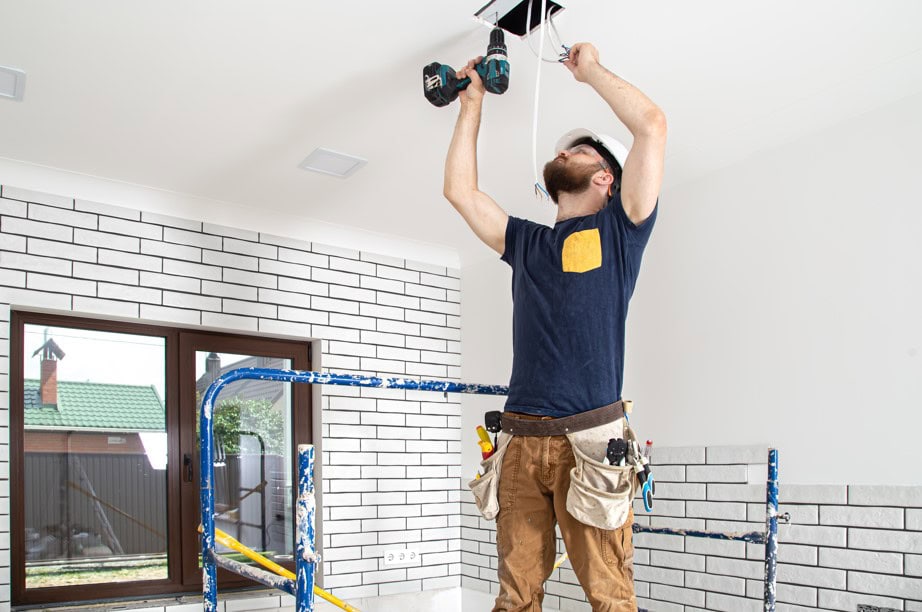When considering home improvements, it’s essential to understand the difference between renovation and remodelling. Although these two terms are frequently used interchangeably, they involve distinct processes.
Understanding the nuances can help you choose the right option for your project, whether you want to refresh your home or completely transform it.
If you’re exploring home renovations in Melbourne, we can provide customised solutions that suit your needs and budget.
Let’s get straight to the point.
Renovation focuses on updating a space without changing its structure, making it faster and more affordable. Remodelling involves altering the layout or structure, making it more complex, costly, and time-consuming.
Renovations are ideal for cosmetic improvements on a budget, while remodelling is suited for major transformations. Renovations usually don’t need permits, but remodelling often does. Renovations tend to offer a higher ROI due to lower costs, while remodelling can add more value but at a higher financial risk.
What Is A Renovation?
A renovation focuses on restoring or updating a space while maintaining its original structure and purpose. Whether it’s upgrading a kitchen or freshening up a bathroom, the main goal of a renovation is to improve aesthetics and functionality without altering the room’s layout or design.
What Is A Remodelling Project?
In contrast to a renovation, remodelling involves altering the structure or layout of a space. Whether knocking down a wall, adding an extension, or converting a garage into a living space, remodelling transforms a room’s functions. This type of project is more complex and often involves significant changes to the home’s structure.

Key Differences Between Renovation And Remodelling
Renovation and remodelling focus on improving a space, yet their approaches and project scopes differ significantly. Understanding these differences helps in making informed decisions about home improvement projects.
1. Scope Of Work
A renovation primarily focuses on updating or restoring an existing space. It aims to refresh the appearance and functionality without altering the layout or structure of the area. This approach often includes replacing outdated fixtures, repainting walls, or modernising finishes.
In contrast, remodelling involves substantial structural changes. It can completely transform the layout and function of a room, making it more suited to the homeowner’s needs. Projects such as removing walls, adding new extensions, or altering the space function typically fall under remodelling.
2. Cost Differences
Renovations are generally more cost-effective than remodelling projects. They focus on upgrading existing features rather than making drastic alterations. Renovations usually involve smaller tasks, such as replacing old flooring or updating cabinetry.
Remodelling projects tend to be more expensive due to the complexity and extent of the work involved. Structural modifications, like moving plumbing, altering electrical wiring, and adding new rooms, require larger investments. Homeowners considering remodelling should be prepared for higher costs.
3. Time Commitment
Since renovations usually involve cosmetic changes or minor repairs, they take less time to complete. Projects like repainting, updating light fixtures, or replacing tiles can often be finished within a few weeks, depending on the size of the room.
Due to their structural nature, remodelling projects typically require more time. Tasks such as demolition, rebuilding, or relocating essential services, like plumbing, extend the project’s timeline. In some cases, remodelling can take several months, especially if the work involves obtaining permits or coordinating multiple contractors.
Choosing Between Renovation And Remodelling
Choosing whether to renovate or remodel depends on several factors, including budget, timeline, and the homeowner’s overall goals for the space.
Renovation Is Ideal For:
- Budget-conscious homeowners who want to update a room without making extensive changes.
- Individuals seek to maintain the existing layout while improving the aesthetics or functionality of a space.
- Projects requiring minor repairs or aesthetic updates, such as replacing outdated fixtures or repainting walls.
Remodelling Is Ideal For:
- Major layout changes: Remodelling is the right option if a room’s design or function needs a complete overhaul.
- Homeowners who are prepared for a larger financial commitment and longer project timelines.
- Projects involving structural changes include knocking down walls, adding extensions, or raising ceilings.
Key Considerations Before Starting Your Project
Before starting a renovation or remodelling project, it’s essential to evaluate your budget, available time, and the goals you have for your home. Here are the critical points to keep in mind:
1. Budget
Renovation is typically the more budget-friendly option. Focyou’reonFocyou’ reon surface-level updates allow for a noticeable transformation without overspending if you work within a limited budget. This could involve painting, updating hardware, or improving lighting.
Because of its structural nature, remodelling usually demands a larger budget. Moving walls, upgrading plumbing, or making additions can quickly drive up costs. Homeowners considering a remodel should understand the financial implications and prepare for unforeseen expenses.
2. Timeline
Since renovations focus on surface-level improvements, they often have shorter timelines. Cosmetic upgrades like installing new flooring or repainting can be completed within weeks, making it a convenient option for those who prefer quick turnarounds.
Because remodelling usually involves more complex construction work, it takes longer. If structural changes are required, such as adding new rooms or altering the layout, the project might extend into several months. Putting in for the extended timeline before starting any remodelling work is essential.
3. Goals For The Space
A renovation is the perfect choice if your primary goal is to modernise a room or fix minor issues. It is suitable for those looking to enhance the appearance or functionality of their home without changing its overall structure.
A remodel is more appropriate if you want to change how a space looks or functions significantly. This is especially true for rooms that no longer serve their intended purpose or require a complete transformation to meet the household’s evolving needs.
Permits: Renovation Vs Remodelling
One key difference between renovation and remodelling is the need for permits. While renovation projects often involve cosmetic changes, remodelling frequently requires approval from local authorities.
Most renovation projects, especially those involving cosmetic updates, do not require permits. Tasks like painting, installing new fixtures, or replacing flooring can typically be completed without involving local building authorities.
Conversely, remodelling projects often involve structural changes, usually requiring building permits. If you’re to knock down a wall, add a room, or make significant changes to the layout, you’ll need to check local regulations and secure the necessary permits before starting the project.
DIY Renovation Vs Professional Remodelling
Deciding whether to tackle a home improvement project yourself or hire a professional depends largely on the scope and complexity of the work.
When To DIY Renovation?
A DIY approach can be rewarding and cost-effective for simple updates, like painting, changing light fixtures, or installing new hardware. These tasks don’t require specialised skills and can often be completed by a homeowner with basic knowledge and tools.
- Painting walls
- Replacing outdated fixtures
- Installing new hardware on cabinets or doors

When To Hire A Professional For Remodelling?
Professionals should handle remediation projects, particularly those involving structural changes. Attempting to DIY complex tasks such as electrical work, plumbing, or knocking down walls can lead to mistakes that could compromise the safety and integrity of your home.
- Electrical wiring or plumbing
- Removing walls or making other structural changes
- Projects that require permits and building code compliance
Return On Investment (ROI): Renovation Vs Remodelling
When deciding between a renovation or remodelling project, homeowners should consider the return on investment (ROI). How much value the project adds to the home can influence the decision.
Renovation ROI
Renovations offer a higher ROI because they focus on improving the home’s appearance and functionality at a lower cost. For example, upgrading a kitchen or bathroom can significantly boost a home’s value without requiring a massive investment. Simple upgrades like repainting or replacing old fixtures often appeal to potential buyers and can significantly increase the home’s value.
Common Renovation Projects With High ROI:
- Kitchen updates, such as new appliances or countertops
- Bathroom upgrades, including new tiles or vanities
- Repainting walls in neutral colours to attract buyers
Remodelling ROI
Remodelling can also provide a strong ROI, but the higher costs may reduce the overall return. Large-scale projects, such as remodelling an entire kitchen or adding a bedroom, can significantly increase a home’s value and require careful planning.
While remodelling projects can make a home more functional and attractive, they also carry a higher risk of not recouping the full investment, depending on the housing market and the quality of the work.
Common Remodelling Projects With High ROI:
- Major kitchen remodelling
- Adding a bedroom or bathroom
- Expanding living spaces with extensions
Conclusion
Understanding the differences between renovation and remodelling is key to making informed decisions for your home improvement project.
Renovations are ideal for cost-effective, quick updates that maintain the existing structure, while remodelling involves more substantial changes and often requires a larger investment and extended timeline.
Whether you’re aiming to modernise or completely transform a space, carefully consider your budget, goals, and potential return on investment to choose the best approach for your home.
FAQs About Home Renovation
What Type Of Construction Is Remodeling?
Changing a home’s structure typically constitutes a significant portion of the remodelling work. For example, changing a wall, partitioning an area, or adding an entirely new room can be classified as a remodelling project.
What Is Considered A Major Remodel?
When we talk about major renovation, we’re referring to the process of remodelling or altering buildings and other structures while keeping them within the framework of an existing building or structure. This includes altering highways and roads that already exist. The contract price for these projects must be greater than $50,000.
Can You Renovate Without An Interior Designer?
In the end, the most important resource you will require to complete a renovation without the assistance of a professional designer is time. It will take you a significant amount of time to oversee the entire project and ensure that everything is completed appropriately and to the level of quality you expect. Putting in the necessary time to complete your renovation can also help save money.
Can You Make Money From Renovating Houses?
A straightforward income-generating tactic is house flipping, which is also known as “fix and flip,” “property trading,” and “fix to sell.” You look around for a home or business that desperately needs repairs and buy it cheaply.
After that, you invest money in making the home significantly more appealing to potential buyers; at this point, you list it on the market for a higher price.
What Is A Soft Refurbishment?
A light renovation might include painting the walls, purchasing new furniture or window treatments, acquiring new artwork, enhancing the storage space, getting the house ready for winter, adding rugs or installing freestanding lighting.
On the other hand, if you are planning a major renovation, it is highly unlikely that you will be able to occupy the space while it is being worked on, at least not without significant difficulty.

